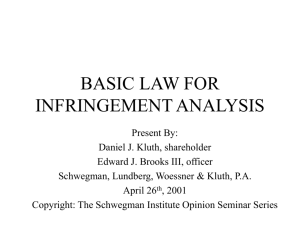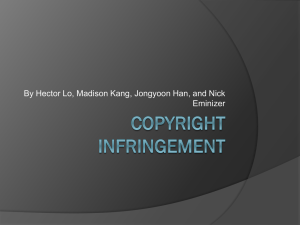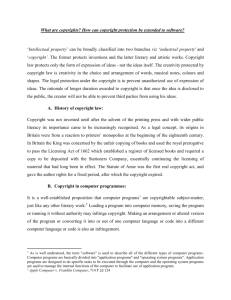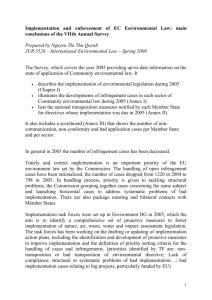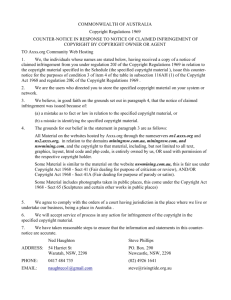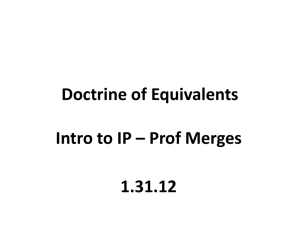ppt
advertisement
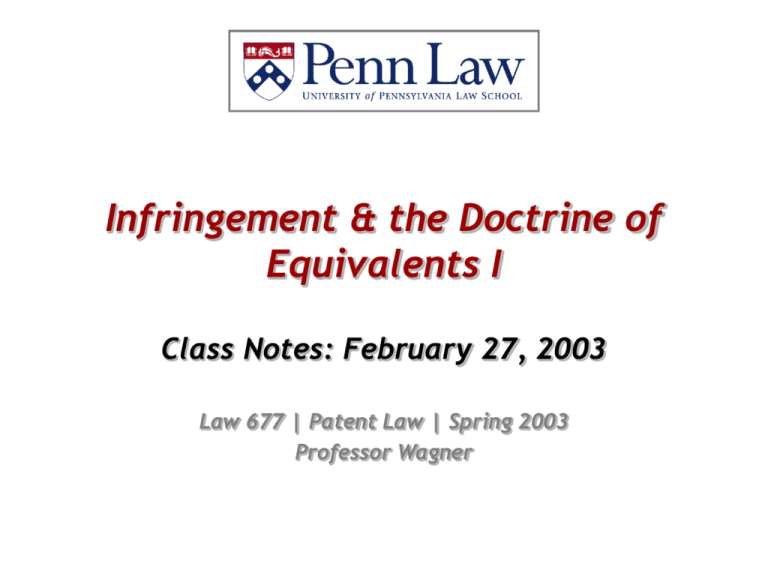
Infringement & the Doctrine of Equivalents I Class Notes: February 27, 2003 Law 677 | Patent Law | Spring 2003 Professor Wagner Today’s Agenda 1. Basics of Infringement 2. The Doctrine of Equivalents 2/27/03 Law 677 | Spring 2003 2 The Basics of Infringement 1. The patent right: the right to exclude others from . . . • • • • • Making Using Selling Offering to sell Importing 2. Categories of Infringement a) Direct Infringement b) Indirect Infringement [March 20] 2/27/03 Law 677 | Spring 2003 3 The Basics of Infringement 1. The patent right: the right to exclude others from . . . • • • • • Making Using Selling Offering to sell Importing 2. Categories of Infringement a) Direct Infringement b) Indirect Infringement [March 20] 2/27/03 Law 677 | Spring 2003 4 The Basics of Infringement (2) 1. Forms of Direct Infringement a) Literal infringement b) Infringement via the Doctrine of Equivalents Literal Infringement => consider this claim . . . 1. A writing implement comprising: A wooden cylinder with a hollow core A cylinder of graphite in said hollow core A small cylinder of eraser material attached to one end of the wooden cylinder Which of the following infringes the claim: • • • A wooden pencil with a small metal clip for shirt-pocket storage A plastic pencil (body made of plastic) A pencil without an eraser 2/27/03 Law 677 | Spring 2003 5 The Doctrine of Equivalents Winans v Denmead (1853) • What was significant about the Winans invention? • Why did the Court find infringement by Denmead? 2/27/03 Law 677 | Spring 2003 6 The Doctrine of Equivalents Graver Tank v Linde (1950) • Technology: welding fluxes • Invention: alkaline earth metal + calcium fluoride • Accused: non-alkaline earth metal + calcium fluoride Why are these facts relevant to infringement? 1. Alkaline and non-alkaline metals performed similarly 2. The prior art suggested that even non-alkaline metals would work 3. No evidence of independent testing by Linde 2/27/03 Law 677 | Spring 2003 7 The Doctrine of Equivalents The Influence of Graver Tank - establishes modern DOE • • • • • • The test for DOE: when the accused device performs “substantially the same function in substantially the same way to achieve substantially the same result” (“Function-Way-Result test”) “What determines equivalency must be determined against the context of the patent, the prior art, and the particular circumstances of the case” “Equivalence, in the patent law, is not the prisoner of a formula and is not an absolute to be considered in a vacuum.” “An important factor is whether persons reasonably skilled in the art would have known of the interchangeability of an ingredient not contained in the patent with one that was.” A finding of equivalence is a determination of fact “The record contains no evidence that [the accused device] was developed as the result of independent research experiments.” 2/27/03 Law 677 | Spring 2003 8 The Doctrine of Equivalents Graver Tank, continued. • How does the majority describe the purpose/use of the DOE? o Would a patent without DOE be a “hollow and useless thing”? • What is the dissent’s primary objection? o Why does the dissent note the possibility of ‘reissue’? • Are you convinced? 2/27/03 Law 677 | Spring 2003 9 The Doctrine of Equivalents Warner-Jenkinson v Hilton Davis (1997) o Key limitation: “a pH of approximately 6.0 to 9.0” o Accused process: pH of 5.0 • Question 1: Does the DOE survive the 1952 Act? • Question 2: What are the boundaries of the DOE? o The court “establishes” the “all-elements-rule”: the DOE is to be applied on an element-by-element basis. (Note that this had been the law of the Federal Circuit since 1987.) – Does the ‘all elements rule’ reconcile the tension between the DOE and the notice function of claims? 2/27/03 Law 677 | Spring 2003 10 The Doctrine of Equivalents Warner-Jenkinson v Hilton Davis (1997) 1. The court declines to determine the appropriate ‘linguistic framework’ for the DOE 2. The DOE remains a question of fact, but see ‘famous footnote 8’ (p. 898) 3. Whether the DOE applies is unrelated to the mental state of the infringer (Why?) 4. Prosecution history estoppel (PHE) survives, with a new ‘presumption’. (Why?) 5. The DOE may apply to any technology, whether known or unknown at the time of filing. (Why is this important?) 2/27/03 Law 677 | Spring 2003 11 The Doctrine of Equivalents What is the ‘best’ argument or explanation for the DOE? 1. Equity/Fairness: An inventor’s rights would be valueless without DOE. 2. Furtherance of the Law’s Purpose: Allowing ‘equivalent’ copies of patented inventions undermines the entire system. 3. (Broad) Claim Construction: we presume patentees have patented all they are entitled to. Does any of these justify the costs of the DOE? 2/27/03 Law 677 | Spring 2003 12 Next Class Infringement & the Doctrine of Equivalents II The All Elements Rule Means-Plus-Function Claims 2/27/03 Law 677 | Spring 2003 13
